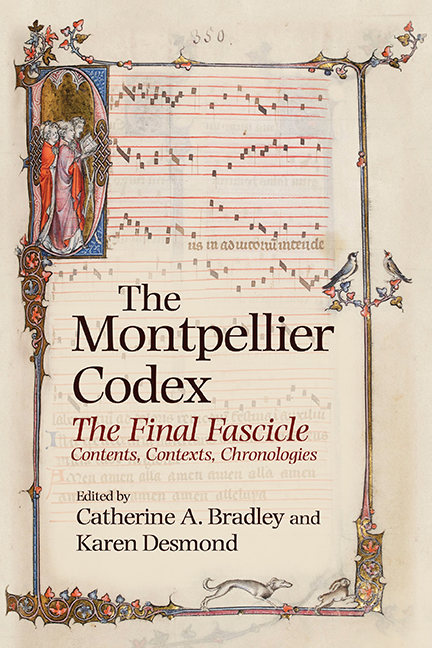Book contents
- Frontmatter
- Contents
- Figures
- Musical examples
- Tables
- Acknowledgements
- List of manuscript sigla
- Abbreviations
- Table of fascicle 8 contents
- Introduction
- I The Material Object
- 1 Montpellier 8: Anatomy of …
- 2 A Palaeographical Analysis of the Verbal Text in Montpellier 8: Problems, Implications, Opportunities
- 3 The Style and Iconography of Montpellier folio 35or
- 4 The Decoration of Montpellier 8: Its Place in the Continuum of Parisian Manuscript Illumination
- 5 Double Motet Layouts in the Montpellier Codex and Contemporaneous Libri motetorum
- 6 Deus in adiutorium Revisited: Sources and Contexts
- 7 Thematic Clusters and Compilational Strategies in Montpellier 8
- II INNOVATION AND TRADITION
- III ANALYTICAL CASE STUDIES
- Bibliography
- Contributors
- General index
- Index of compositions, alphabetical
- Index of compositions in Mo, manuscript order
- Miscellaneous Endmatter
2 - A Palaeographical Analysis of the Verbal Text in Montpellier 8: Problems, Implications, Opportunities
from I - The Material Object
Published online by Cambridge University Press: 04 July 2019
- Frontmatter
- Contents
- Figures
- Musical examples
- Tables
- Acknowledgements
- List of manuscript sigla
- Abbreviations
- Table of fascicle 8 contents
- Introduction
- I The Material Object
- 1 Montpellier 8: Anatomy of …
- 2 A Palaeographical Analysis of the Verbal Text in Montpellier 8: Problems, Implications, Opportunities
- 3 The Style and Iconography of Montpellier folio 35or
- 4 The Decoration of Montpellier 8: Its Place in the Continuum of Parisian Manuscript Illumination
- 5 Double Motet Layouts in the Montpellier Codex and Contemporaneous Libri motetorum
- 6 Deus in adiutorium Revisited: Sources and Contexts
- 7 Thematic Clusters and Compilational Strategies in Montpellier 8
- II INNOVATION AND TRADITION
- III ANALYTICAL CASE STUDIES
- Bibliography
- Contributors
- General index
- Index of compositions, alphabetical
- Index of compositions in Mo, manuscript order
- Miscellaneous Endmatter
Summary
SEVERAL chapters of this volume seek a firmer dating for the copying of Mo 8 than has heretofore been ascertained, their arguments based on stylistic comparison of the fascicle's musical repertory and artistic work with a broad base of dated and datable materials. As palaeographers have long taught us, script, too, has style. No less than the work of artists and composers, that of scribes was conditioned by the changing needs of those who used their products, as new patterns of book use emerged, supporting and supported by a growing book trade in the later Middle Ages. Like colleagues working in other artistic media, scribes responded to changes in taste and fashion. Thus scripts belong to history and, under certain circumstances, hands may be datable.
Dates offered for Mo have ranged broadly even in recent scholarship, in no small part because disagreements remain about whether and to what extent Montpellier is a composite codex – or, to put this the other way around, whether and to what extent it was planned as a whole. How someone construes the material evidence naturally affects how that scholar dates the manuscript (or some portion of it). There is not space here to review all the codicological, palaeographical, and art-historical work relevant to the issue; but reliable accounts of earlier scholarship exist already. Suffice it to say that the earliest dating proposed for fascicle 8 would place it in the 1270s – a suggestion of Mary E. Wolinski. The latest might put it as far into the fourteenth century as the 1320s – a possibility floated by Yvonne Rokseth in the 1930s, and compatible with some of the new evidence offered in this volume by Alison Stones (who finds that ‘a date in the decade of c.1315–25 for the execution of Mo 8 would be most likely’). Covering six decades, this is a broad range.
Research on Mo's production constitutes a sizeable and imposing – indeed, a daunting and inspiring – body of scholarship, still more impressive given that some of its most important contributions were written when their authors were students, and before any widespread use of the technologies of manuscript reproduction upon which the field has come so heavily to rely.
- Type
- Chapter
- Information
- The Montpellier CodexThe Final Fascicle. Contents, Contexts, Chronologies, pp. 32 - 65Publisher: Boydell & BrewerPrint publication year: 2018
- 1
- Cited by

